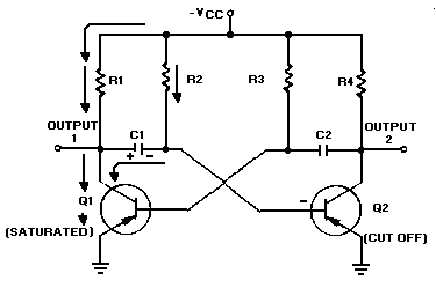3-7
output remains at each voltage level for a definite period of time. If you looked at this output on an
oscilloscope, you would see continuous square or rectangular waveforms. The astable multivibrator has
two outputs, but NO inputs.
Let's look at the multivibrator in figure 3-3 again. This is an astable multivibrator. The astable
multivibrator is said to oscillate. To understand why the astable multivibrator oscillates, assume that
transistor Q1 saturates and transistor Q2 cuts off when the circuit is energized. This situation is shown in
figure 3-4. We assume Q1 saturates and Q2 is in cutoff because the circuit is symmetrical; that is,
R1 = R4, R2 = R3, C1 = C2, and Q1 = Q2. It is impossible to tell which transistor will actually conduct
when the circuit is energized. For this reason, either of the transistors may be assumed to conduct for
circuit analysis purposes.
Figure 3-4.—Astable multivibrator (Q1 saturated).
Essentially, all the current in the circuit flows through Q1; Q1 offers almost no resistance to current
flow. Notice that capacitor C1 is charging. Since Q1 offers almost no resistance in its saturated state, the
rate of charge of C1 depends only on the time constant of R2 and C1 (recall that TC = RC). Notice that
the right-hand side of capacitor C1 is connected to the base of transistor Q2, which is now at cutoff.
Let's analyze what is happening. The right-hand side of capacitor C1 is becoming increasingly
negative. If the base of Q2 becomes sufficiently negative, Q2 will conduct. After a certain period of time,
the base of Q2 will become sufficiently negative to cause Q2 to change states from cutoff to conduction.
The time necessary for Q2 to become saturated is determined by the time constant R2C1.
The next state is shown in figure 3-5. The negative voltage accumulated on the right side on
capacitor C1 has caused Q2 to conduct. Now the following sequence of events takes place almost
instantaneously. Q2 starts conducting and quickly saturates, and the voltage at output 2 changes from
approximately
-
VCC to approximately 0 volts. This change in voltage is coupled through C2 to the base of
Q1, forcing Q1 to cutoff. Now Q1 is in cutoff and Q2 is in saturation. This is the circuit situation shown
in figure 3-6.

